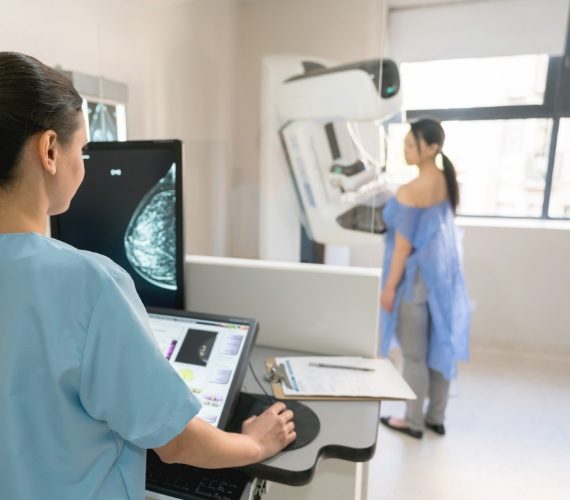Login
Imaging Services
Mammography
Our staff is here to make your mammogram quick and comfortable.
Mammogram and COVID-19 Vaccine
Current Guidelines from Society of Breast Imaging for Scheduling Your Screening Mammogram and COVID-19 Vaccine.
If it is time for your routine mammogram and you are eligible for the COVID-19 vaccine, the guidelines suggest trying to schedule the screening mammogram before getting the first dose of the vaccine or four-to-six weeks after getting the second vaccine dose.
However, if your mammogram has been postponed due to the pandemic, please do not delay your mammogram screening due to your vaccination. If you notice changes in your breasts or have any concerns, please do not delay care: call your doctor right away.
To schedule your mammogram, click here to select a location.
The History
All women share the risk of breast cancer, and the risk increases significantly for women who have a family history of breast cancer. Regular screenings make it possible to detect breast cancer early, which is key to a cure. This includes knowing what is normal for you. This means how they look and feel and having a yearly mammogram.
A mammogram is an X-ray from the side and top of the breast.
It’s important for the early detection of breast cancer, because it can detect a lump three to five years before it can be felt by a doctor.
During a mammogram, your breasts are pressed between two pieces of plastic for a few seconds, while a minimal X-ray dose, similar to that of a dental X-ray, is applied. Pressing your breast in this way may be briefly uncomfortable.
Who Should Get a Mammogram?
According to the American Cancer Society, women age 40 and older should have a screening mammogram every year and should continue to do so for as long as they are in good health.
Women at high risk (greater than 20 percent lifetime risk) should get an MRI and a mammogram every year.
Women at moderately increased risk (15 to 20 percent lifetime risk) should talk with their doctors about the benefits and limitations of adding MRI screening to their yearly mammogram.
Yearly MRI screening is not recommended for women whose lifetime risk of breast cancer is less than 15 percent.

Preparing for Your Mammogram
Although a mammogram can be performed at any time, you may prefer to schedule your mammogram during the 10 days following your menstrual period because your breasts are likely to be less tender. The day of your test, don’t apply deodorant, perfumes or powders to your breasts or under arms. And relax! Our staff is here to make your mammogram quick and comfortable.
The Procedure
ChristianaCare offers several convenient mammogram locations. The Breast Center offers comprehensive breast care in one convenient location. You can also have your mammogram performed at one of our outpatient ChristianaCare Imaging locations or at Wilmington Hospital.
After the results of your mammography are reviewed by experienced board-certified radiologists who sub-specialize in mammography, they are then forwarded to your doctor.
When an abnormal area shows up on a mammogram, other imaging studies may be recommended. Your doctor will discuss these options with you.

Notes
Schedule an Appointment

Imaging Services at West Grove
900 West Baltimore Pk
Suite 102
West Grove, PA 19390












